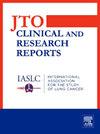Longitudinal Circulating Tumor DNA–Guided Resistance Analysis During Second-Line Osimertinib Treatment
IF 3.5
Q2 ONCOLOGY
引用次数: 0
Abstract
Introduction
In osimertinib-treated EGFR mutation (EGFRm)–positive NSCLC, resistance inevitably occurs. Early resistance mechanism (RM) detection by circulating tumor DNA (ctDNA) in plasma and consecutive targeted treatment may delay progressive disease (PD). In this multicenter prospective study, we evaluated the detection rate and time interval of RM emergence in plasma ctDNA before radiologic PD.
Methods
Patients with EGFRm–positive NSCLC, treated with second- or third-line osimertinib, underwent computed tomography of the thorax and ctDNA analysis (Roche AVENIO expanded panel, research use only [Roche Sequencing Solutions, Roche, Basel, Switzerland]) at baseline and every 8 weeks for response evaluation and EGFRm and RM detection. If MET amplification preceded PD, crizotinib was to be added to osimertinib. Other RMs were monitored but not acted on. After PD, patients underwent a tumor biopsy.
Results
Of the 21 evaluable patients, 18 had detectable ctDNA at baseline. In patients with undetectable ctDNA at baseline, ctDNA remained undetectable during treatment. In the 17 out of 18 (94%) patients with detectable ctDNA, PD occurred. In seven out of 21 patients (33%), the EGFRm variant allele frequency increase preceded radiologic PD with a median interval of 9 weeks (range 7–34). In seven out of 21 patients (33%), at least one RM was detected before PD, and the median interval was 14 weeks (range 7–34). Three had one or more RM in ctDNA at baseline. No MET amplification was observed, and treatment with crizotinib was not initiated in any patient. After PD, 16 biopsies were obtained. Five confirmed the RM detected in plasma, five biopsies revealed additional RMs, and six harbored no RM.
Conclusions
In 33% of patients treated with second- or third-line osimertinib, RMs in plasma preceded PD by a median of 14 weeks, suggesting an opportunity for early treatment adjustment, potentially extending tyrosine kinase inhibitor treatment duration.
奥西替尼二线治疗期间纵向循环肿瘤dna引导耐药性分析
在奥西替尼治疗的EGFR突变(EGFRm)阳性NSCLC中,不可避免地会发生耐药性。通过血浆循环肿瘤DNA (ctDNA)检测早期耐药机制(RM)和连续靶向治疗可延缓进展性疾病(PD)。在这项多中心前瞻性研究中,我们评估了放射PD前血浆ctDNA中RM出现的检出率和时间间隔。方法EGFRm阳性NSCLC患者,接受二线或三线奥西替尼治疗,在基线和每8周进行胸部计算机断层扫描和ctDNA分析(罗氏AVENIO扩展面板,研究仅使用[罗氏测序解决方案,罗氏,巴塞尔,瑞士]),以评估疗效和EGFRm和RM检测。如果MET扩增先于PD,则将克唑替尼添加到奥西替尼中。其他rm受到监控,但没有采取行动。PD后,患者接受肿瘤活检。结果在21例可评估的患者中,18例基线时可检测到ctDNA。在基线时ctDNA检测不到的患者中,ctDNA在治疗期间仍然检测不到。在18例可检测到ctDNA的患者中,17例(94%)发生PD。在21例患者中有7例(33%),EGFRm变异等位基因频率在放射学PD之前增加,中位间隔为9周(范围7-34周)。21例患者中有7例(33%)在PD前至少检测到1例RM,中位间隔为14周(范围7-34周)。其中三人在基线时ctDNA有一个或多个RM。未观察到MET扩增,未在任何患者中开始使用克唑替尼治疗。PD后,行16例活检。5例证实血浆中检测到RM, 5例活检发现额外RM, 6例未发现RM。结论:在接受二线或三线奥西替尼治疗的患者中,33%的患者血浆RMs在PD之前的中位数为14周,这表明有机会早期调整治疗,可能延长酪氨酸激酶抑制剂的治疗时间。
本文章由计算机程序翻译,如有差异,请以英文原文为准。
求助全文
约1分钟内获得全文
求助全文
来源期刊

JTO Clinical and Research Reports
Medicine-Oncology
CiteScore
4.20
自引率
0.00%
发文量
145
审稿时长
19 weeks
 求助内容:
求助内容: 应助结果提醒方式:
应助结果提醒方式:


